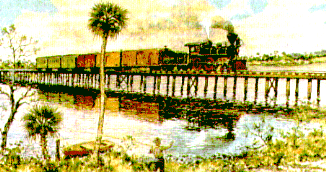Florida Development
During the final quarter of the nineteenth century, large-scale commercial agriculture in Florida, especially cattle-raising, grew in importance. Industries such as cigar manufacturing took root in the immigrant communities of the state.
Potential investors became interested in enterprises that extracted resources from the water and land. These extractive operations were as widely diverse as sponge harvesting in Tarpon Springs and phosphate mining in the southwestern part of the state. The Florida citrus industry grew rapidly, despite occasional freezes and economic setbacks. The development of industries throughout the state prompted the construction of roads and railroads on a large scale.
Beginning in the 1870s, residents from northern states visited Florida as tourists to enjoy the state's natural beauty and mild climate. Steamboat tours on Florida's winding rivers were a popular attraction for these visitors.
The growth of Florida's transportation industry had its origins in 1855, when the state legislature passed the Internal Improvement Act. Like legislation passed by several other states and the federal government, Florida's act offered cheap or free public land to investors, particularly those interested in transportation. The act, and other legislation like it, had its greatest effect in the years between the end of the Civil War and the beginning of World War I. During this period, many railroads were constructed throughout the state by companies owned by Henry Flagler and Henry B. Plant, who also built lavish hotels near their railroad lines. The Internal Improvement Act stimulated the initial efforts to drain the southern portion of the state in order to convert it to farmland.
These development projects had far-reaching effects on the agricultural, manufacturing, and extractive industries of late-nineteenth-century Florida. The citrus industry especially benefitted, since it was now possible to pick oranges in south Florida; put them on a train heading north; and eat them in Baltimore, Philadelphia, or New York in less than a week.
In 1898 national attention focused on Florida, as the Spanish-American War began. The port city of Tampa served as the primary staging area for U.S. troops bound for the war in Cuba. Many Floridians supported the Cuban peoples' desire to be free of Spanish colonial rule.
By the turn of the century, Florida's population and per capita wealth were increasing rapidly; the potential of the "Sunshine State" appeared endless. By the end of World War I, land developers had descended on this virtual gold mine. With more Americans owning automobiles, it became commonplace to vacation in Florida. Many visitors stayed on, and exotic projects sprang up in southern Florida. Some people moved onto land made from drained swamps. Others bought canal-crossed tracts through what had been dry land. The real estate developments quickly attracted buyers, and land in Florida was sold and resold. Profits and prices for many developers reached inflated levels.
